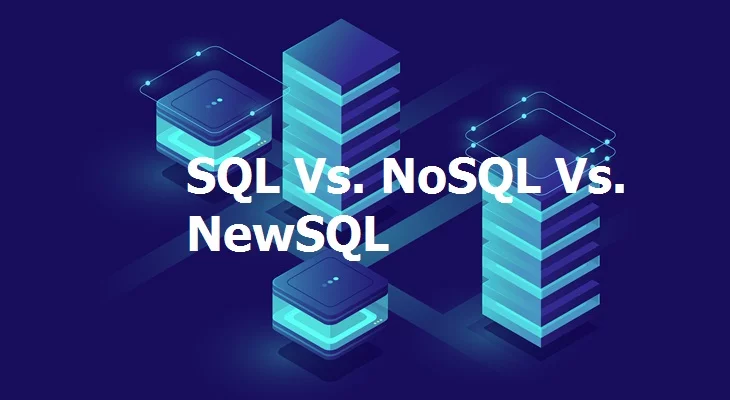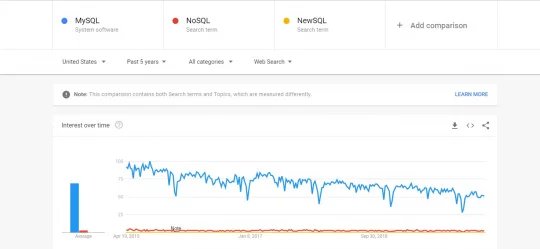The structured query is a useful tool in database communication, and data transfer and data retrieval. The traditional structured approach was working fine until the rise of big data technology.
But as the emphasis on the big data grew, developers started to shift their focus from the structured to unstructured approach. We will be comparing the traditional SQL with modern NoSQL and NewSQL in this blog.
SQL Vs. NoSQL Vs. NewSQL: Differentiated Across Various Parameters
As per the Google trends, SQL is by far the most popular programming language amongst SQL, NoSQL, and NewSQL.
But, the key reason behind this popularity is the fact that users often search for tools in the case of NewSQL and NoSQL. But, the user focus is on the SQL term and not the tools.
SQL is a traditional, and structured approach to database programming. It has been available to us for years. And it still works fine in many of the cases. So, if your existing SQL is working fine, then you don’t need to change it, just for the sake of it.
NoSQL is a horizontally scalable programming language. It is created to overcome the flaws of SQL by moving away from a standardized form of SQL. It is a relatively newer term than SQL, but this has been present for some time now.
While on the other hand, NewSQL is an attempt to combine both SQL and NoSQL. NewSQL provides a relational database more scalability without having to lose ACID (atomicity, consistency, isolation, and durability).
SQL works with logical and physical architecture. Logical architecture defines data storage, grouping, trigger actions, etc. Physical architecture defines the location of the database in the system.
But, the architecture of NoSQL varies with every data model. There are two common data models that are used in NoSQL.
They are known as the key-based NoSQL data model and graph-based NoSQL data model. Key-based data models allow access to certain sections based on the key values or documents. Graph models grant users access on the basis of the relationship between data.
NewSQL architecture implements a distributed data technology with three key tiers. These tiers include an admin tier, a transactional tier, and a storage tier. These systems can easily scale horizontally as well as vertically.
Also Read: Apache Kafka vs. JMS: Difference Explained
Traditional SQL is more focused on ACID properties and useful in vertical scaling. Atomicity allows the developers to check if the transaction is reflected or not.
Consistency maintains data preservation after the transaction. Isolation ensures that every transaction is different and unrelated to concurrent transactions. Durability allows the system to keep the changes made even in the system failures.
While on the other hand, NoSQL works on BASE properties and on no sharing architecture. The BASE means Basically Available Stable State.
The key focus is on the availability at all times and partition. Even though it is less consistent than SQL, it is a proactive approach. It is used when you need to perform faster actions, and data availability is essential.
But, NewSQl supports both ACID and BASE properties. It supports the cloud environment and also offers full online transactional processing that is an essential property in modern-day programming.
With the distributed approach, it can offer ease of scaling and solving complex queries as well.
Though, it uses a structured approach, SQL is still useful in big data technology. As the SQL is schema oriented, you need to understand the data structure in advance. It is difficult in big data, and this is what led to the invention of NoSQL.
The scalability and flexibility offered by the NoSQL allows the system to keep track of multichannel data. It is an essential parameter in big data.
NoSQL addresses the key challenges in big data such as data capture, data storage, and data processing with ease.
Some of the popular SQL tools include dbWatch, Visual Expert, Jet Profiler, EMS SQL Manager, etc.
And the popular examples of NewSQL include VoltDB, ClustrixDB, CockroachDB, Pivotal, NuoDB, Altibase, MemSQL etc.
While on the other hand, some of the popular examples of NewSQL are: AmazonDynamoDB, MongoDB, CouchDB, RavenDB, FatDB, Redis, etc.
Key Takeaways:
While SQL still remains relevant and important in this digitally transformed world, the NoSQL is catching up with it. But more importantly, it is NewSQL that will dominate the years to come as it consists of pros of both the programming languages.
You may also like to read:






